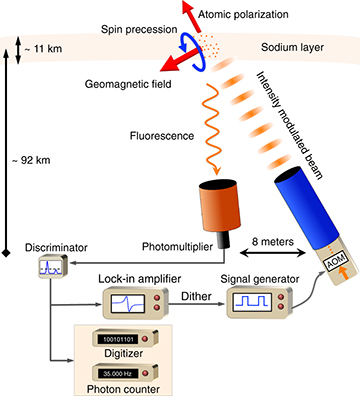![]()
Polar mesospheric clouds. [Image: NASA]
Laser-created “guide stars” form a key part of the adaptive-optics (AO) techniques that have revolutionized astronomy, by setting up ways for ground-based telescopes to see through atmospheric distortions. In work published this year, several research groups have found another use for these laser-induced artificial lanterns: pinning down the shape and intensity of Earth’s magnetic field at a scientifically crucial—and, previously, largely inaccessible—range.
Wobbling beacons
In AO techniques using guide stars, a powerful laser adjacent to a ground-based telescope zaps a small piece of Earth’s middle atmosphere, or mesosphere, 85 to 100 km above the telescope. The consequent excitation of sodium atoms in the mesosphere creates an artificial point of light at a precise, known location and elevation. That winking light source, in turn, gives the telescope operators on the ground a known point to grab onto, and lets them computationally cancel out (via wavefront-shaping techniques) the turbulence in the lower atmosphere. The result? A sharper view of the stars beyond.
In 2011, scientists led by James Higbie of Bucknell University, USA, suggested that laser guide stars for AO might also function as tiny, remote magnetometers for measuring Earth’s mesospheric magnetic field (Proc. Natl. Acad. Sci. USA, doi: 10.1073/pnas.1013641108). The approach would work through measurements of the precession, or wobbling, of the laser-excited sodium atoms in the magnetic field.
More specifically, as the circularly polarized laser beam excites the sodium atoms, it also spin-polarizes them, which causes them to wobble like spinning tops in the magnetic field. The frequency of that precession, which depends on the local field strength, can be read via changes in the fluorescence signal captured by a ground-based detector.
Such measurements, if they could be made to work, would prove a nice win for geophysics. That’s because the mesosphere occupies a difficult-to-access middle zone between space-based and ground-based measurements of the magnetic field. Yet understanding that elusive part of the field is crucial to a complete picture of overall geomagnetism, for scientific applications ranging from plate tectonics to ocean circulation to space weather.
Experimental tests
In May of this year, a group of U.S. researchers finally put the idea of using wobbling laser guide stars as magnetometers to the test (J. Geophys. Res., doi: 10.1029/2018JA025178). The team fired a 1.33-W laser to excite mesospheric sodium atoms, and then gathered the backscattered guide star light with a 1.55-m-aperture telescope. By measuring the precession, they were able to obtain a value of the field consistent with several models “within a fraction of a percent.” But the method’s sensitivity, at 162 nT/Hz½, fell considerably short of the level of around 1 nT/Hz½ thought to be necessary for useful measurements of mesospheric magnetic-field variations.
A team of scientists from Germany, Italy, Canada and the U.S. used a ground-based laser developed for astronomical adaptive optics, equipped with an acousto-optical modulator (AOM), to excite sodium atoms in the mesosphere. Ground-based measurement of the optical signal was used to estimate the precession of the spin-polarized sodium atoms and, thus, of the Earth’s magnetic field in that area. [Image: F.P. Bustos et al., Nat. Commun., doi: 10.1038/s41467-018-06396-7; CC BY 4.0] [Enlarge image]
In work published at the end of September, scientists from Germany, Italy, Canada and the United States reported a significant improvement on that accuracy (Nat. Commun., doi: 10.1038/s41467-018-06396-7). They aimed a continuous-wave laser from the European Southern Observatory’s laser guide star unit adjacent to the William Herschel Telescope on La Palma, Canary Islands at the mesosphere, delivering roughly 2 W of laser power to the sky. The team then captured the received light with a 40-cm-aperture telescope mounted on the AO system’s receiver control unit. The received light, after passing through a photomultiplier tube, was then sent to a digital signal-processing stack for backing out the precession from the fluorescence signal, and for tuning the laser to reduce scintillation noise from the atmosphere.
Boosting sensitivity
By focusing on a narrower resonance frequency in the precession signal, the international team reported, the researchers were able to achieve accuracy of 0.28 mG/Hz½ (28 nT/Hz½)—“an order of magnitude better sensitivity” than the U.S. team’s result early in the year, albeit still below the ultimate 1-nT/Hz½ target. The international group suggested that the results could be improved still further; using higher laser powers, for example, would allow researchers to boost the number of atoms interrogated by the method, sharpening sensitivity.
The researchers also noted an interesting side-effect of the recent work. By digging into the details of resonance frequencies tied to the excited sodium atoms’ spin-relaxation rate, they were able to suss out information on the rates of atomic collisions in the mesosphere. Getting such quantitative information on collisional dynamics, the team wrote, is “important for the optimization of sodium laser guide stars and mesospheric magnetometers”—and could thus further improve the potential usefulness of these beacons for astronomy and geophysics alike.

